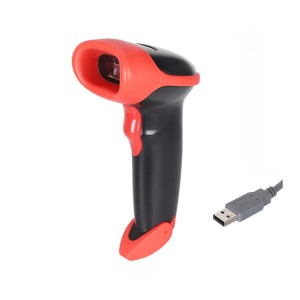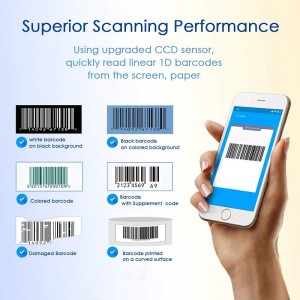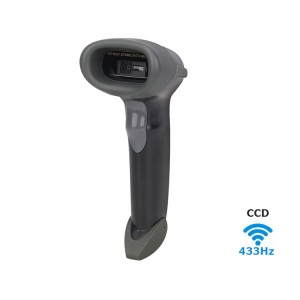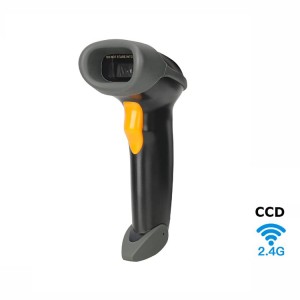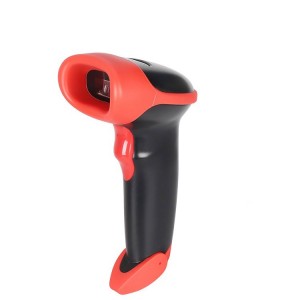Although it is said that a variety of 2D barcode scanners currently dominate the advantage, but in some use scenarios, 1D barcode scanners still occupy a position that can not be replaced. Although most of the 1D barcode gun is to scan paper-based, but in order to meet the current very popular mobile payment, there are some models of 1D CCD bar code scanner gun also began to have the function of scanning mobile phones and other electronic screen code.
1.What is a 1D red light barcode scanner?
1D barcodes are a pattern consisting of one-dimensional lines and spaces, and common types include EAN-13, CODE39, CODE128, and so on.
The principle of CCD scanning technology is to use a red light beam to irradiate the barcode, the barcode reflects the red light, and the scanner detects the change of reflected light through the photoelectric sensor, and then decodes the information on the barcode. Red light scanning technology is fast, accurate and stable, and is suitable for a variety of working environments.
The 1D CCD barcode scanner has a wide range of applications in various industries. In the retail industry, it can be used for merchandising, inventory management and price label scanning. In logistics and warehousing, it can quickly scan and track goods. In healthcare, libraries and other areas, it can be used to track and manage items. In addition, 1D CCD bar code scanners play an important role in manufacturing, transportation, food safety and other industries. It improves work efficiency, reduces the error rate of manual operations and improves overall work performance.
2.Characteristics and challenges of screen codes
2.1. A screen code is a special type of QR code that is displayed on the screen of an electronic device. It can be scanned to read the QR code information on the screen. Screen Code has a wide range of application scenarios, including e-payment, e-ticketing, e-identity verification and so on. For example, payment is made by scanning the screen code on the mobile phone, or entry verification is made by scanning the screen code on the e-ticket.
2.2. The main characteristics of screen codes include low contrast, reflection and refraction problems, etc.
Low contrast: Since the display of QR codes on the screen is limited by the brightness and contrast of the screen, sometimes the black and white contrast of QR codes is low, making it difficult for scanning devices to detect them accurately.
Reflection problem: The light on the screen is reflected back to the scanning device, making it difficult for the scanning device to distinguish the boundaries and details of the QR code. This may result in the screen code not being correctly recognised by the scanning device.
Refraction problem: During the process of scanning the on-screen code, the light is refracted many times by the scanning device and the screen, which may result in the scanning device not being able to read the information on the QR code accurately.
2.3. Traditional 1D CCD barcode scanners face a number of challenges when scanning on-screen codes.
Low contrast challenge: Traditional 1D CCD barcode scanners may not be able to read low-contrast on-screen codes. Since the display of screen codes is limited by the brightness and contrast of the screen, the scanning device may not be able to correctly capture and decode the information in the 2D code.
Reflection and refraction challenges: Light from on-screen codes is reflected and refracted, making it difficult for scanners to accurately read QR codes. Traditional CCD 1D barcode scanners are typically designed to scan paper barcodes and may not be able to effectively address the reflection and refraction issues of screen codes.
To overcome these challenges, there are now devices specifically designed to scan screen codes, such as 2D scanners or specialised screen code scanners. These devices use more advanced scanning technology to better capture and decode the information on screen codes.
If you have any interest or query during the selection or use of any barcode scanner, please Click the link below send your inquiry to our official mail (admin@minj.cn) directly! MINJCODE is committed to the research and development of barcode scanner technology and application equipment, our company has 14 years of industry experience in the professional fields, and has been highly recognized by the majority of customers!
3.
3.1 Certain 1D CCD barcode scanners have the ability to scan on-screen codes. These scanners are specially designed to efficiently identify and decode 2D code information displayed on the screen. They can read screen codes with low contrast, reflection and refraction problems to provide accurate results.
3.2 Product standards and performance specifications are important when scanning on-screen codes. Because screen codes have special scanning requirements, only scanners with the appropriate technology and features can scan them effectively. Therefore, when purchasing a 1D CCD barcode scanner, make sure it has the ability to scan the screen code and pay attention to the relevant product standards and performance indicators, such as scanning accuracy, reflection suppression and refraction resistance.
In the digital era, 1D CCD bar code scanner has broad business value and prospects. It can be used in retail, logistics, transportation, ticketing and other industries to improve work efficiency and provide a convenient user experience. Therefore, choosing the right 1D CCD barcode scanner and understanding its ability to scan on-screen codes is an important step towards digital transformation.
We hope this knowledge helps all our customers understand the features of our scanners, feel free to click to contact our sales staff and get a quote today.
If You Are in Business, You May Like
Recommend Reading
Post time: Jul-27-2023


